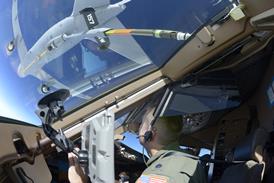Guy Norris and Paul Lewis/SEATTLE
Boeing is confident that it will launch the 777-200X and -300X within three months. The company rebuts suggestions that the project is slowing down because of market uncertainty and concerns over performance.
Programme manager Jeff Peace says: "We are very serious about it and have targeted first delivery for September 2000." Revealing details about the schedule for the proposed long-range twins, Peace says that the -200X will lead the longer -300X by four months from August 1998, when major assembly of the -200 derivative is due to start.
A firm configuration is to be decided in May 1998 for both derivatives, with first flight of the -200X due in January 2000. The -300X initial flight is set for May that year.
Boeing is confident that the concerns of some carriers, particularly those of Singapore Airlines (SIA), over potential range/performance shortfalls are being met by late design changes. "The aircraft can make the routes the airlines are after. We think the airlines are getting confident in that too," he says.
The latest modifications centre on provision of more fuel in the outboard and inboard wing, as well as auxiliary belly-tanks for the ultra-long-range -200X version. "It makes the -200X virtually a 9,000nm [16,650km]-range aeroplane," says Peace.
The -300X - carrying up to 355 people in a three-class layout, compared to 298 in the -200X - is expected to fly up to 12,580km with the Rolls-Royce Trent 8104, or 12,300km with the Pratt & Whitney PW4098.
Changes to the wing include extending the wingbox outboard by 1.3m, in addition to the revised rake on the wingtip, which adds 690mm to the span. The total span increase is 2m per wing, resulting in an overall wingspan of 65m - roughly that of the 747-400.
Fuel capacity will rise to 181,500litres, compared to 171,400litres in the -200IGW (increased gross weight). Provision is being made for two 9,200litre auxiliary tanks in the aft of the lower cargo bay. Extra space has also been found for an additional 1,100litres per wing in the R-R version. The Trent, which is shorter than the PW4098, is suspended further forward on the pylon and therefore a "dry bay" is not needed in the wing to allow for a turbine-rotor burst.
Further concerns over SIA's extremely long-range routes could be met by the use of direct routing (under the free-flight concept) and changing operating procedures, such as only half filling the aircraft's large potable-water supply, says Peace. The maximum take-off weights of 333,700kg for the -200X and 324,600kg for the -300X are now fixed, he adds.
Boeing plans to certificate and deliver three versions of the stretched 777-300, at 73.8m the longest airliner ever built, in an unprecedented ten months after a flight-test effort starting in mid-October.
The first version to be certificated will be the R-R Trent 892-powered -300, which was rolled out on 8 September in Seattle. The 500h flight-test effort will concentrate on basic aerodynamic qualities, flutter clearance, control-law stability and take-off performance. The number one aircraft, WB501, is due to be certificated in May 1998 and handed over to launch customer Cathay Pacific Airways in the same month.
Two subsequent R-R-powered aircraft will join the test programme over the next three months, with certification work on the second version, a P&W PW4090-powered aircraft, starting in mid-November. This 200h programme is to be completed in early March, with full certification expected by June. The first PW4090-powered -300 will be delivered to All Nippon Airways.
Flight-testing begins of the third variant, with the more-powerful PW4098, in February 1998.
Source: Flight International























